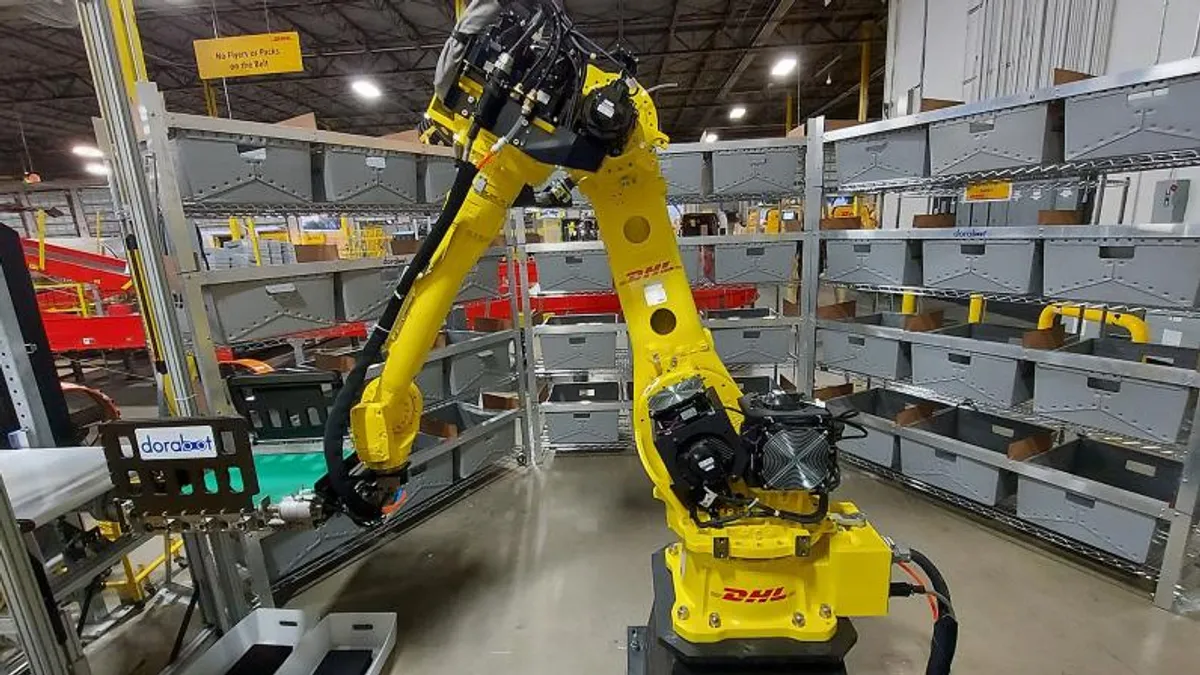Dive Brief:
- DHL eCommerce Solutions' installation of two robotic sorting systems at an Atlanta distribution center has boosted sortation throughput and labor efficiency over the past year, executives said in an online presentation Monday.
- The DoraSorter robotic systems from Dorabot are each able to sort more than 1,000 pieces hourly, and they allow output to improve "by a factor up to four," Dorabot CEO Spencer Deng said in a statement. One system sorts packages into postal bags for distribution to 80 final-mile ZIP code destinations, while the other sorts pieces into 20 separate Gaylord containers.
- The systems are part of the DHL division's $100 million investment in automated parcel sorting systems, which is set to be complete in 18 months, said Scott Ashbaugh, VP of operations for DHL eCommerce Solutions, Americas. "This is a big step for our business and allows us to upskill our employees to utilize this kind of equipment," Ashbaugh said.
Dive Insight:
The investment in automated sortation is a key piece of the $300 million DHL eCommerce Solutions is spending to expand and improve its U.S. operations — and the additions go beyond Dorabot's systems.
Ashbaugh said in addition to two loop sorters already in place in its network today, two more will be installed next year in Cincinnati and Chicago that sort 40,000 to 50,000 pieces per hour. The DHL division is also adding more line sorters, which are smaller than loop sorters and process around 14,000 pieces an hour, to its network.
"They really are the workhorses of the network, and so we've expanded that program dramatically," Ashbaugh said. "The machines we're buying now are roughly twice as fast as the old generation legacy systems."
Industrial robot orders hit a record high in 2021 as a wide range of industries raced to address demand while grappling with labor challenges. Robotics and automation are in use today by 28% of respondents to the 2022 MHI Annual Industry Report's survey, but the adoption rate is expected to grow to 79% in the next five years.
But DHL eCommerce Solutions began pursuing higher levels of automation before the COVID-19 pandemic. The robotic sorting systems are a long term investment to improve safety and efficiency at warehouses, not a quick fix for near-term labor challenges, Ashbaugh said. The company needed to bring in additional workers just to keep pace with elevated volume levels once the pandemic accelerated e-commerce growth.
"When COVID hit, there's not enough lead time to build and install those things to respond to the volume spike fast enough," Ashbaugh said. "So we were extremely dependent on being able to bring in a tremendous amount of workforce to be able to deal with the COVID surge."
DHL eCommerce Solutions' technological evolution also includes devices to help warehouse employees work more efficiently, Ashbaugh said. The division has been using overhead scanners that remove the need for handheld scanners, freeing up an extra hand for workers.
The overhead scanners are still in the testing phase, but DHL eCommerce Solutions plans to have them deployed in all 19 of its distribution centers, according to a spokesperson.
This story was first published in our Operations Weekly newsletter. Sign up here.













